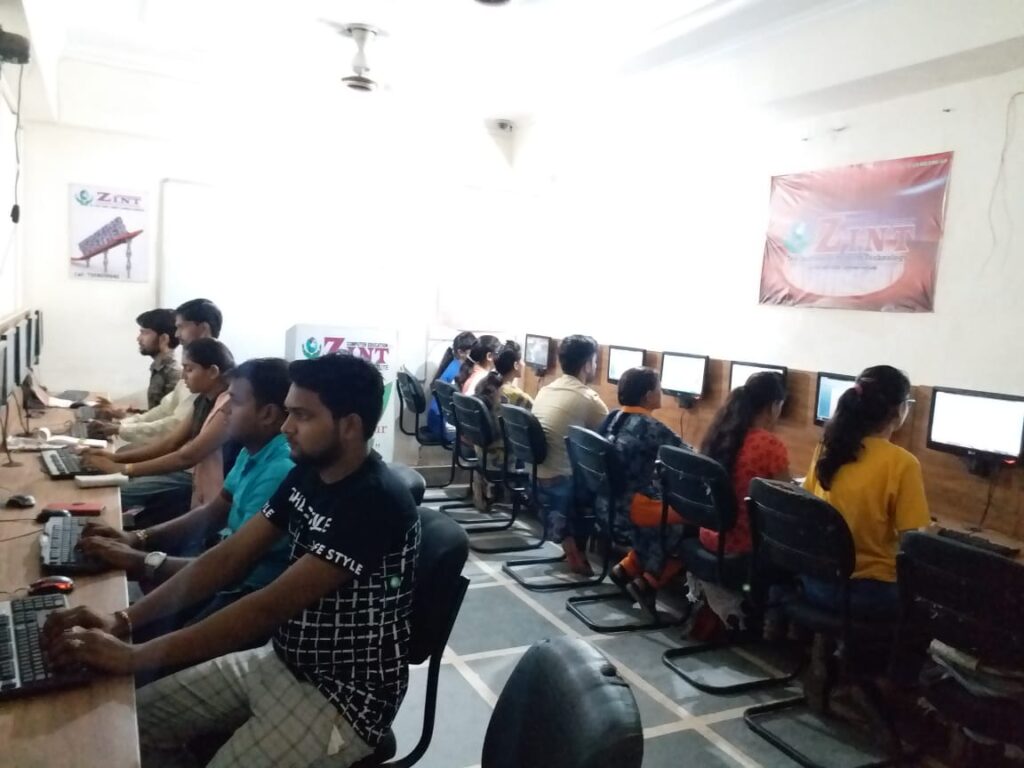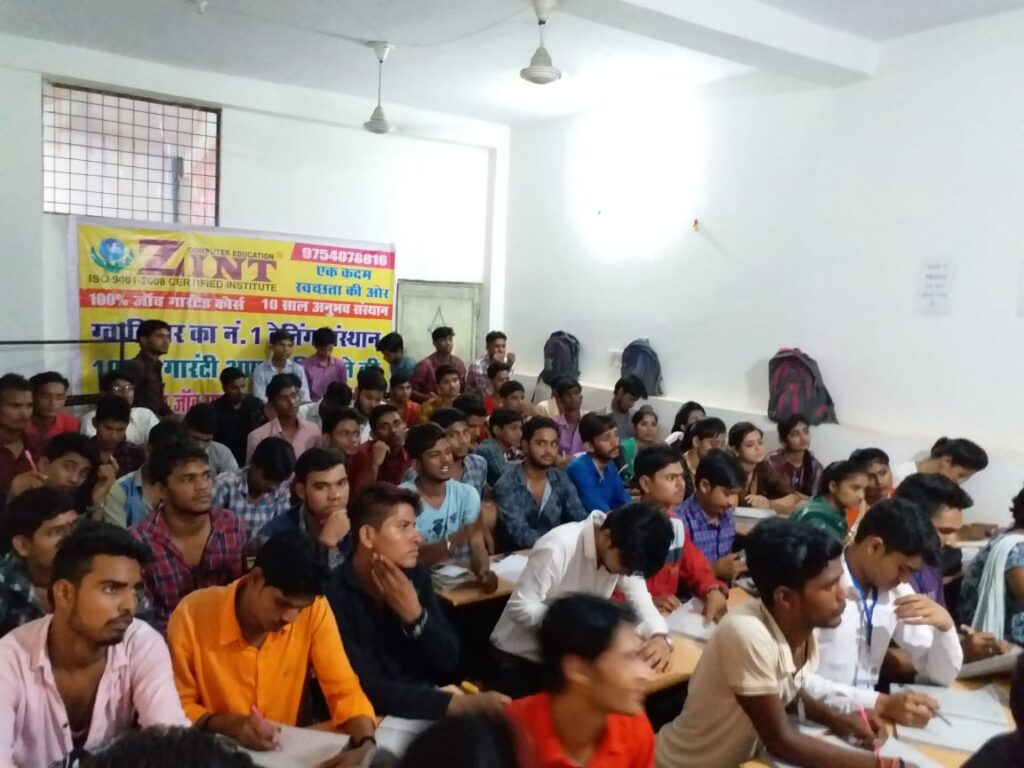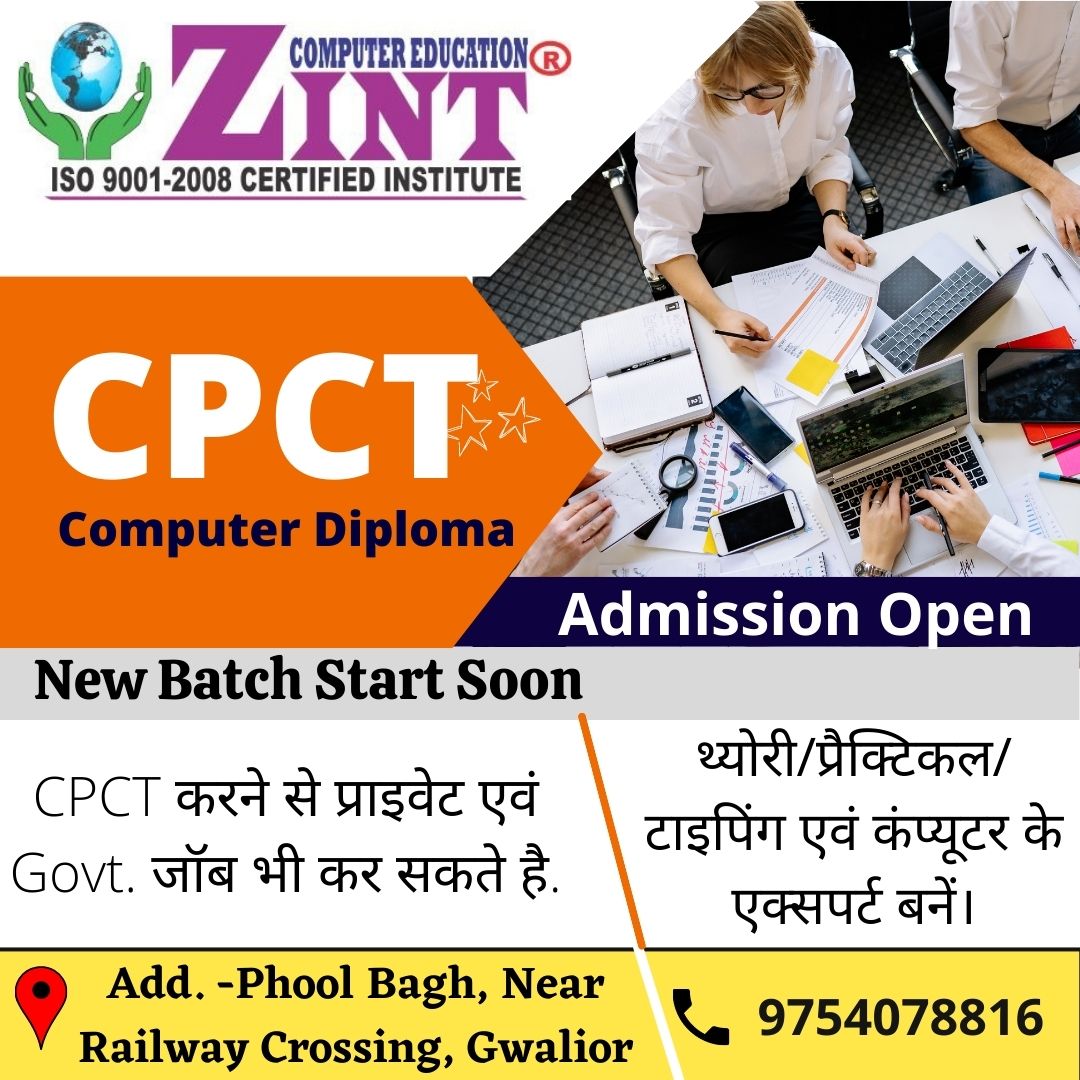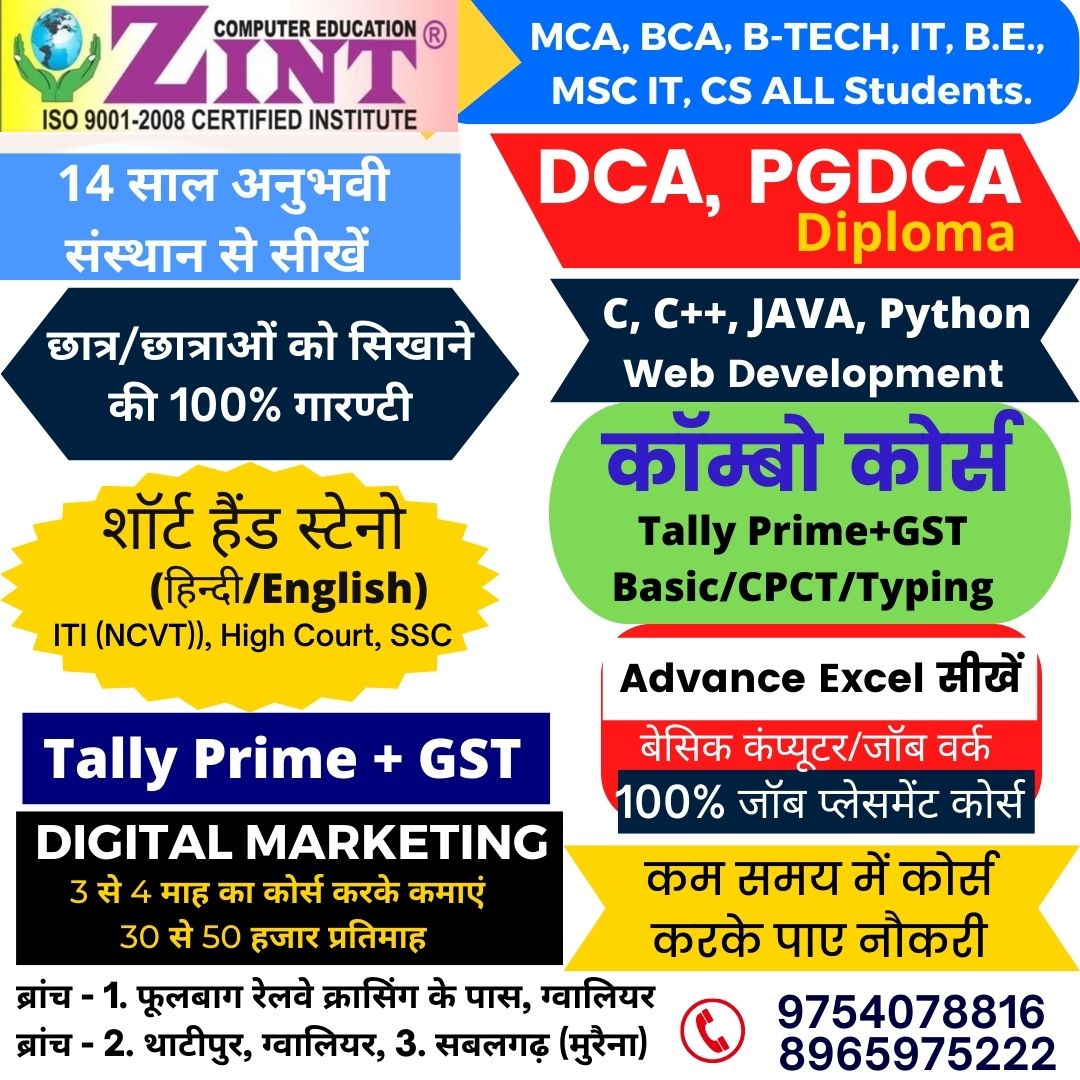Basic Computer Courses
Computer Courses
Basic Computer Course
This course is designed to aim at imparting a basic level IT Literacy programme for the common man. This programme has essentially been conceived with an idea of giving an opportunity to the common man to attain computer literacy thereby contributing to increased and speedy PC penetration in different walks of life. After completing the course the incumbent should be able to the use the computer for basic purposes of preparing his personnel/business letters, viewing information on internet (the web), receiving and sending mails, preparing his business presentations, preparing small databases etc. This helps the small business communities, housewives, etc. to maintain their small accounts using the computers and enjoy in the world of Information Technology. This course is, therefore, designed to be more practical oriented.

Get An Excellent Class Course on Computer Course
Get An Excellent Class Course on Computer Course
Zint Institute is a leading Computer training institute in Gwalior because we have 10+ years of knowledgeable and talented instructor which delivers real-time live Computer course training in Gwalior. We have designed this course for job seekers, students, working professionals and entrepreneurs
Basic Computer Syllabus
1.0 Introduction
1.1 Part of computer
1.2 What is Computer?
1.2.1 History of Computers
1.2.2 Characteristics Of Computer System
1.2.3 Basic Applications of Computer
1.3 Components of Computer System
1.3.1 Central Processing Unit
1.3.2 Keyboard, mouse and VDU
1.3.3 Other Input devices
1.3.4 Other Output devices
1.3.5 Computer Memory
1.4 Concept of Hardware and Software
1.4.1 Hardware
1.4.2 Software
1.4.2.1 Application Software
1.4.2.2 Systems software
1.4.3 Programming Languages
1.5 Representation of Data/Information
1.6 Concept of Data processing
1.7 Applications of IECT
1.7.1 e-governance
1.7.2 Multimedia and Entertainment
1.8 Summary
1.9 Model Questions and Answers
2.0 Introduction
2.1 Objectives
2.2 Basics of Operating System
2.2.1 Operating system
2.2.2 Basics of popular operating system (LINUX, WINDOWS)
2.3 The User Interface
2.3.1 Task Bar
2.3.2 Icons
2.3.3 Start Menu
2.3.4 Running an Application
2.4 Operating System Simple Setting
2.4.1 Changing System Date and Time
2.4.2 Changing Display Properties
2.4.3 To Add or Remove a Windows Component
2.4.4 Changing Mouse Properties
2.4.5 Adding and removing Printers
2.5 File and Directory Management
2.6 Types of files
2.7 Summary
2.8 Model Questions and Answers iv (Revision I)
3.0 Introduction
3.1 Objectives
3.2 Word Processing Basics
3.2.1 Opening Word Processing Package
3.2.2 Menu Bar
3.2.3 Using The Help
3.2.4 Using The Icons Below Menu Bar
3.3 Opening and closing Documents
3.3.1 Opening Documents
3.3.2 Save and Save as
3.3.3 Page Setup
3.3.4 Print Preview
3.3.5 Printing of Documents
3.4 Text Creation and manipulation
3.4.1 Document Creation
3.4.2 Editing Text
3.4.3 Text Selection
3.4.4 Cut, Copy and Paste
3.4.5 Font and Size selection
3.4.6 Alignment of Text
3.5 Formatting the Text
3.5.1 Paragraph Indenting
3.5.2 Bullets and Numbering
3.5.3 Changing case
3.6 Table Manipulation
3.6.1 Draw Table
3.6.2 Changing cell width and height
3.6.3 Alignment of Text in cell
3.6.4 Delete / Insertion of row and column
3.6.5 Border and shading
3.7 Summary
3.8 Model Questions and Answers
4.0 Introduction
4.1 Objectives
4.2 Elements of Electronic Spread Sheet
4.2.1 Opening of Spread Sheet
4.2.2 Addressing of Cells
4.2.3 Printing of Spread Sheet
4.2.4 Saving Workbooks
4.3 Manipulation of Cells
4.3.1 Entering Text, Numbers and Dates
4.3.2 Creating Text, Number and Date Series
4.3.3 Editing Worksheet Data
4.3.4 Inserting and Deleting Rows, Column
4.3.5 Changing Cell Height and Width v (Revision I)
4.4 Function and Charts
4.4.1 Using Formulas
4.4.2 Function
4.4.3 Charts
4.5 Summary
4.6 Model Questions and Answers
5.0 Introduction
5.1 Objectives
5.2 Basics of Computer Networks
5.2.1 Local Area Network (LAN)
5.2.2 Wide Area Network (WAN)
5.3 Internet
5.3.1 Concept of Internet
5.3.2 Basics of Internet Architecture
5.4 Services on Internet
5.4.1 World Wide Web and Websites
5.4.2 Communication on Internet
5.4.3 Internet Services
5.5 Preparing Computer for Internet Access
5.5.1 ISPs and examples (Broadband/Dialup/WiFi)
5.5.2 Internet Access Techniques
5.6 Summary
5.7 Model Questions and Answers
6.0 Introduction
6.1 Objectives
6.2 Web Browsing Software
6.2.1 Popular Web Browsing Software
6.3 Configuring Web Browser
6.4 Search Engines
6.4.1 Popular Search Engines / Search for content
6.4.2 Accessing Web Browser
6.4.3 Using Favorites Folder
6.4.4 Downloading Web Pages
6.4.5 Printing Web Pages
6.5 Summary 6.6 Model Questions and Answers
7.0 Introduction
7.1 Objectives
7.2 Basics of E-mail
7.2.1 What is an Electronic Mail
7.2.2 Email Addressing
7.2.3 Configuring Email Client
7.3 Using E-mails VI (Revision I)
7.3.1 Opening Email Client
7.3.2 Mailbox: Inbox and Outbox
7.3.3 Creating and sending a new E-mail
7.3.4 Replying to an E-mail message
7.3.5 Forwarding an E-mail message
7.4 Advance email features
7.4.1 Sending document by E-mail
7.4.2 Activating Spell checking
7.4.3 Using Address book
7.4.4 Sending Softcopy as attachment
7.4.5 Handling SPAM
7.5 Instant Messaging and Collaboration
7.5.1 Using Smiley
7.5.2 Internet etiquettes
7.6 Summary
7.7 Model Questions and Answers
8.0 Introduction
8.1 Objectives
8.2 Basics
8.2.1 Using PowerPoint
8.2.2 Opening A PowerPoint Presentation
8.2.3 Saving A Presentation
8.3 Creation of Presentation
8.3.1 Creating a Presentation Using a Template
8.3.2 Creating a Blank Presentation
8.3.3 Entering and Editing Text
8.3.4 Inserting and Deleting Slides in a Presentation
8.4 Preparation of Slides
8.4.1 Inserting Word Table or An Excel Worksheet
8.4.2 Adding Clip Art Pictures
8.4.3 Inserting Other Objects
8.4.4 Resizing and Scaling an Object
8.5 Providing Aesthetics
8.5.1 Enhancing Text Presentation
8.5.2 Working with Color and Line Style
8.5.3 Adding Movie and Sound
8.5.4 Adding Headers and Footers
8.6 Presentation of Slides
8.6.1 Viewing a Presentation
8.6.2 Choosing a Set Up for Presentation
8.6.3 Printing Slides and Handouts
8.7 Slide Show
8.7.1 Running a Slide Show
8.7.2 Transition and Slide Timings
8.7.3 Automating a Slide Show
8.8 Summary
8.9 Model Questions and Answers

Why Choose Us For Computer Concept Course In Gwalior
कुछ ऐसे विद्यार्थी हैं जो पैसों की अभाव में ग्वालियर जैसे बड़े शहर में पढ़ने में सक्षम नहीं हो पाते हैं। परंतु ZINT इंस्टिट्यूट अपनी कम शुल्क के साथ इन छात्रों की मदद के लिए आगे आया है। यहां ग्रामीण स्तरीय अथवा कमजोर आर्थिक स्थिति वाले भी बच्चे पढ़ सकते हैं।
जेड आई एन टी (ZINT INSTITUTE) कोचिंग की स्थापना नवंबर 2010 में रमेश शिवहरे सर के द्वारा की गई इस संस्था के सभी Best & Experience Faculty हैं।
- प्रत्येक छात्र कोर्स करने के बाद 10000/- से 20000/- रुपये प्रतिमाह कमाएं
- हमारे यहां स्पेशल क्लास की सुविधा उपलब्ध है.
- कमजोर छात्र-छात्राओं के लिए विशेष सुविधाएं उप्लब्ध हैं।
- हमारे यहाँ प्रत्येक कोर्स में अलग-अलग Theoretical एवं Practical कराने की सुविधा है। एवं छात्र छात्राओं को एक्स्ट्रा क्लास भी दी जाती है
- शनिवार के दिन पूरे सप्ताह में जो भी पढ़ाई हुई है उसका Revision कराया जाता है।
- कोर्स के हर विषय की पढ़ाई टॉपिक बाई टॉपिक कराई जाती है, जिससे उसे समझने एवं प्रैक्टिकल में बहुत ज्यादा सहयोग मिलता है
- कोर्स करने के बाद इंटरव्यू की भी तैयारी भी कराई जाती है
- प्रत्येक कोर्स की पढ़ाई एक्सपर्ट शिक्षकों द्वारा कराई जाती है.
- यहां previous year के प्रश्न पत्र हल कराए जाते हैं।
- हमारे यहां दूर एवं नज़दीक से आने वाले प्रत्येक छात्रों छात्राओं के लिए रहने एवं खाने के लिए कम दामों में हॉस्टल की सुविधा उपलब्ध कराई जाती है ?
- बेरोजगारी को देखते हुए कम फीस में पढ़ाने की सुविधा उपलब्ध है.
- Missed class की अलग से क्लासेज लगाई जाती है।
- जिन छात्र / छात्राओं का कोर्स पूरा हो जाता है उसे एक्सपर्ट बनाने के लिए सर्विस सेन्टर में तीन माह के लिए भेज देते हैं.
- कमजोर छात्र / छात्राओं पर सबसे ज्यादा ध्यान दिया जाता है ओर उन्हें एक्स्ट्रा क्लास एवं एक्स्ट्रा ट्रेनर द्वारा सपोर्ट दिया जाता है
- क्लास में बैठने की उच्त्तम व्यवस्था है
- प्रत्येक batch में छात्रों की संख्या न्यूनतम रखी जाती है क्लास में २० छात्र / छात्राएं बैठते है जिससे पढ़ाने में एवं समझने में कोई भी प्रोब्लम नहीं होती
- क्लास में मोबाइल चलाने की अनुमति नहीं दी जाती है
- बच्चों को best educator के hand written notes दिए जाते हैं।
- संस्थान के सभी टीचर योग्य एवं अनुभवी जिन्हें 8 से 12 साल का पढ़ाने का अनुभव है ?
- पढ़ाई की आधुनिक तरीका अपनाया गया है।
- फीस इंस्टॉलमेंट में ली जाती है जिससे छात्र छात्राओं को फीस देने में कोई भी परेशानी नहीं होती
- कोर्स कम्पलीट होने के बाद इंटरव्यू की भी तैयारी भी कराई जाती है ?
- कोर्स के बाद इंटर्नशिप के लिए भी भेजते है
- कमजोर छात्रों के लिए स्पेशल बैच बनाये जाते है जिससे उन्हें ज्यादा से ज्यादा टाइम दिया जाये
- यहां पर छात्रों को best faculty दी जाती है।
- Doubt क्लास में क्लियर किया जाता है, जिससे candidates को पूर्ण संतुष्टि मिले।
- ऑनलाइन एवं ऑफलाइन क्लास की सुविधा।
- विद्यार्थी का daily basic report तैयार किया जाता है।
- यहां हॉस्टल की सुविधा उपलब्ध है।
- Monthly fee का उचित सीमा रखा गया है, जिसको सभी विद्यार्थी बिना कठिनाई से दे सकें।
- बीते हुए क्लासेज का daily revision कराया जाता है।
Our Courses

Steno Short Hand (हिन्दी/English)

CPCT Diploma

Basic Computer Course

Tally Prime & GST

DCA | PGDCA Diploma

